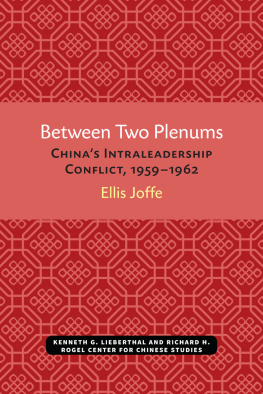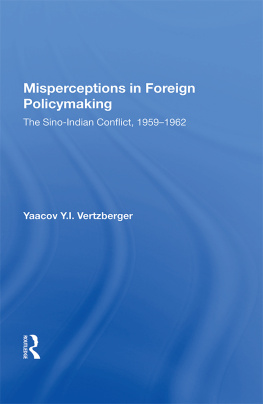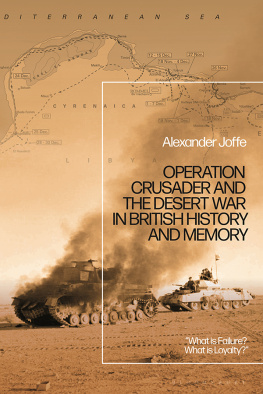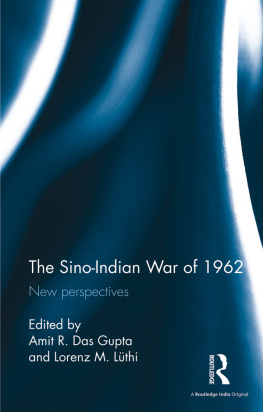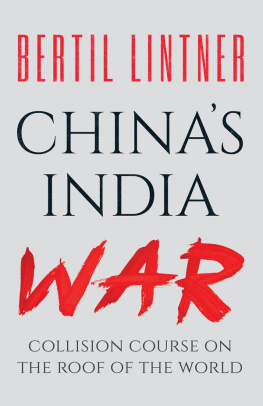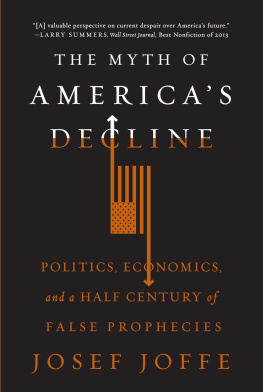Ellis Joffe - Between Two Plenums: China’s Intra Leadership Conflict, 1959-1962
Here you can read online Ellis Joffe - Between Two Plenums: China’s Intra Leadership Conflict, 1959-1962 full text of the book (entire story) in english for free. Download pdf and epub, get meaning, cover and reviews about this ebook. year: 2020, publisher: Kenneth G. Lieberthal and Richard H. Rogel Center for Chinese Studies, genre: Science. Description of the work, (preface) as well as reviews are available. Best literature library LitArk.com created for fans of good reading and offers a wide selection of genres:
Romance novel
Science fiction
Adventure
Detective
Science
History
Home and family
Prose
Art
Politics
Computer
Non-fiction
Religion
Business
Children
Humor
Choose a favorite category and find really read worthwhile books. Enjoy immersion in the world of imagination, feel the emotions of the characters or learn something new for yourself, make an fascinating discovery.
- Book:Between Two Plenums: China’s Intra Leadership Conflict, 1959-1962
- Author:
- Publisher:Kenneth G. Lieberthal and Richard H. Rogel Center for Chinese Studies
- Genre:
- Year:2020
- Rating:5 / 5
- Favourites:Add to favourites
- Your mark:
- 100
- 1
- 2
- 3
- 4
- 5
Between Two Plenums: China’s Intra Leadership Conflict, 1959-1962: summary, description and annotation
We offer to read an annotation, description, summary or preface (depends on what the author of the book "Between Two Plenums: China’s Intra Leadership Conflict, 1959-1962" wrote himself). If you haven't found the necessary information about the book — write in the comments, we will try to find it.
Ellis Joffe: author's other books
Who wrote Between Two Plenums: China’s Intra Leadership Conflict, 1959-1962? Find out the surname, the name of the author of the book and a list of all author's works by series.
Between Two Plenums: China’s Intra Leadership Conflict, 1959-1962 — read online for free the complete book (whole text) full work
Below is the text of the book, divided by pages. System saving the place of the last page read, allows you to conveniently read the book "Between Two Plenums: China’s Intra Leadership Conflict, 1959-1962" online for free, without having to search again every time where you left off. Put a bookmark, and you can go to the page where you finished reading at any time.
Font size:
Interval:
Bookmark:

THE UNIVERSITY OF MICHIGAN
CENTER FOR CHINESE STUDIES
MICHIGAN PAPERS IN CHINESE STUDIES
NO. 22
BETWEEN TWO PLENUMS: CHINAS INTRA LEADERSHIP CONFLICT, 1959-1962
by
Ellis Joffe
Ann Arbor
Center for Chinese Studies
The University of Michigan
1975
Open access edition funded by the National Endowment for the Humanities/Andrew W. Mellon Foundation Humanities Open Book Program.
Copyright 1975
by
Center for Chinese Studies
The University of Michigan
Printed in the United States of America
ISBN 978-0-89264-022-5 (hardcover)
ISBN 978-0-472-03836-7 (paper)
ISBN 978-0-472-12813-6 (ebook)
ISBN 978-0-472-90213-2 (open access)
The text of this book is licensed under a Creative Commons Attribution-NonCommercial-NoDerivatives 4.0 International License: https://creativecommons.org/licenses/by-nc-nd/4.0/
CONTENTS
Selected Bibliography
The major part of this short monograph was completed while I was a Research Associate at The University of Michigans Center for Chinese Studies during the academic year 1971-72. For enabling me to spend this year at Michigan, from which I derived immense personal pleasure and professional benefit, and for the hospitality accorded me, I am deeply grateful to the directors and members of the Center for Chinese Studies. I am especially indebted to Professors Albert Feuerwerker, Rhoads Murphey, Michel Oksenberg, Allen Whiting, Ernest Young and Dr. David Denny for commenting on the manuscript, to Professor Oksenberg for taking the trouble to write a preface, to Jeannie Lin for editing the text, and to Ros Daly for many favors. I alone, of course, am responsible for the final product.
Ellis Joffe
The Hebrew University of Jerusalem
May 1975
Quebec, Cairo, Teheran, Yalta, Potsdam mention of these dramatic World War II diplomatic conferences immediately sparks debates among American diplomatic historians who have different reconstructions of these turning points in world history.
Thanks particularly to documentation obtained during the Cultural Revolution, Western analysts of contemporary China now proudly possess a similar roll call of meetings to hash and rehash: for example from the the late 1958-62 era, Wuhan, 1958; Second Chengchow; Lushan, 1959; the Ninth Plenum; the Grandview Guest House meeting; the Meeting of the 7000; the West Guest House meeting; and the Tenth Plenum. To the nonspecialist outsider, these names may seem esoteric, mysterious. But to the leaders of China, the list immediately evokes vivid memories of crucial meetings where they grappled with problems of the immediate post-Great Leap era: the economic depression; the growing Sino-Soviet dispute; and the nations loss of ideological commitment.
Students of post-1949 Chinese politics generally agree that the 1959-62 era was pivotal, and that the fate of the nation hung in the balance at the meetings which Ellis Joffe seeks to untangle in this useful monograph. Scholars also tend to believe that the elite tensions which culminated in the Cultural Revolution of 1966-69 arose at least as early as 1959-62. However, little agreement exists over precisely what happened during those years or how it happened. In particular, many argue that Mao Tse-tung slipped from power in those years and that Liu Shao-chi led the post-Leap economic and political rehabilitation, largely in opposition to Mao. According to this argument, the Cultural Revolution was Maos way of regaining power lost initially in 1958-62.
The research for this monograph was done in 1971-72 in Ann Arbor when Professor Joffe was a Research Associate of the Center for Chinese Studies, but the writing was completed in Israel in 1973-74. Rejecting a Mao-in-command model, he highlights elite strife, and argues that the 1958-62 era involved a complex interplay among the top leaders. Through his reading of the Cultural Revolution materials released through 1972, Joffe concludes that after Lushan, Maos personal power was challenged at the major Party meetings. Joffe believes that Mao was able to publically maintain an image of consensus among his associates throughout the difficult period through ambiguity and obfuscating of controversial issues. But Mao was not always successful, and on several occasions the lines of conflict were sharply drawn.
A word on Joffes sources is appropriate. He draws extensively upon the so-called Cultural Revolution or Red Guard materials, e.g., publications of various nongovernmental groups during the 1966-69 era. The pamphlets, newspapers, posters, and handbills were based in part on materials secured through raids on state and Party archives and through official leaks. These materials then filtered out of China to Hong Kong and elsewhere, where they were procured by various research agencies. Since the information in these materials is not always reliablefor example, Red Guard charges against Liu Shao-chi or Teng Hsiao-ping seem distortedcare is required in using them.
Ellis Joffe has sought confirmation of Red Guard accusations through the documentation of the time. For example, he substantiates some Red Guard revelations about the 1959 Lushan Plenum through a careful reading of Peoples Daily of 1959 and through 1959-60 reports of informed Western observers. Further, Joffe has tried to draw primarily upon Red Guard reproductions of entire speeches; by and large, he admits that short quotations could easily have been taken out of context. Finally, he has not accepted Red Guard portrayals of the motivations, personalities, and personal relations of various Chinese leaders; instead, he has focused upon Red Guard disclosures of actual words and deeds.
As a result, Joffes reconstruction of 1959-62 differs in instances from the picture proposed by the Red Guards and by Western analysts who have perhaps overexuberantly accepted Red Guard charges. The net effect is that Joffe argues that a cleavage between Mao and his associates erupted during the 1959-62 era, but the fissure between the two lines was not as sharply drawn as it was to become in 1965-66. It is a valuable and timely argument to have in print.
Michel Oksenberg
Ann Arbor, Michigan
March 1975
Since the Cultural Revolution erupted on the Chinese political scene, more seems to have been written about this great upheaval than about its origins. Two main reasons probably account for this. First, the Cultural Revolution was an epic political struggle unprecedented in its dimensions and openness in the history of the regime; accordingly, it is bound to be more rewarding to researchers than the opaque political maneuverings which preceded it. More importantly, because the Cultural Revolution was a relatively open affair, it threw up reams of materials which, for all their shortcomings, enable the analyst to follow the development of the upheaval in a more direct fashion than any other episode in the annals of the Chinese Peoples Republic. To be sure, these materials also constitute a major source for the study of the pre-Cultural Revolution period, but they are much less revealing and reliable about this period than about the Cultural Revolution itself. Thus, it is easier to trace the course of the Cultural Revolution than to delve into the conflicts and controversies which caused it.
The difficulty of dealing with the pre-Cultural Revolution period is underlined by the fact that scholars who have studied this period are divided in their interpretations. These scholars can be grouped, perhaps somewhat simplistically, into two basically divergent schools of thought. According to Frederick Teiwes, the first school exhibits a widespread tendency to adopt, albeit with significant variations and modifications, concepts derived from Pekings own two line struggle model of political conflict. Teiwes characterizes this school as follows:
Font size:
Interval:
Bookmark:
Similar books «Between Two Plenums: China’s Intra Leadership Conflict, 1959-1962»
Look at similar books to Between Two Plenums: China’s Intra Leadership Conflict, 1959-1962. We have selected literature similar in name and meaning in the hope of providing readers with more options to find new, interesting, not yet read works.
Discussion, reviews of the book Between Two Plenums: China’s Intra Leadership Conflict, 1959-1962 and just readers' own opinions. Leave your comments, write what you think about the work, its meaning or the main characters. Specify what exactly you liked and what you didn't like, and why you think so.

